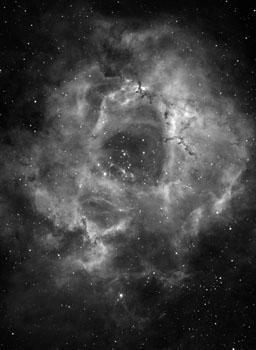
Filters for Imaging
The most basic use for filters is for taking color images. By shooting through red, green, and blue colored filters it is possible to capture objects in full color. Filters can also be used to enhance certain details, to block light pollution, or to isolate certain features of an object for either aesthetic or scientific purposes.
How Filters Work
Filters work by isolating certain wavelengths of light. They allow only certain portions of the spectrum of light to pass. For example, a red filter passes only the wavelengths of light which appear red to our eyes.

Above: A red filter transmits light between the wavelengths of 600 and 700 nanometers (nm), the red portion of the visible spectrum.
A narrowband filter transmits a much smaller portion of the spectrum. This is useful for isolating certain features of an object. For example, emission nebulas give off much of their light at a wavelength of 656.3 nm. This wavelength corresponds to light given off by excited hydrogen atoms which are the primary constituent of emission nebulas. Instead of passing a 100-nm-wide section of the spectrum, a narrowband filter might have a bandpass of only several nanometers. For more details on narrowband CCD imaging, click here.

Above: A hydrogen-alpha filter transmits light centered on a wavelength of 656.3 nm with a typical bandpass of around 4 nm.
Blocking Light Pollution
One of the biggest advantages of narrowband filters is that by passing only the light emitted by nebulae, light from artificial sources like street lights is blocked. This allows you to take detailed exposures of nebulas from a suburban location that can rival shots from much darker sites.
Above: An image of the Rosette Nebula, taken with a 4" refractor and hydrogen-alpha filter from a suburban backyard. Click image for a higher-resolution version.
Using narrowband filters has one potential drawback: it only works for emission nebulas, which emit light at specific frequencies. Objects such as galaxies and star clusters emit their light at all wavelengths. However, it is possible to use broadband light-pollution filters to reduce the effects of city lights. Broadband filters block only the wavelengths of light given off by the primary components of light pollution but pass all other wavelengths. One drawback is the increased exposure time, but with fast telescopes and high-sensitivity CCD cameras becoming common, this is an acceptable trade-off in exchange for being able to image from a light-polluted area.

Above: A broadband light-pollution filter blocks the light given off by certain streetlights and other sources of artificial skyglow but allows all other wavelengths to pass.
For objects other than nebulas, such as galaxies and clusters, broadband filters allow light pollution to be blocked while transmitting enough light for standard RGB images of these subjects. Many CCD imagers, however, manage to make do without broadband filters since much of the effect of light pollution can be removed using image processing software. (See the Advanced Image Processing section.) But for extreme light pollution, a broadband filter can be very helpful.
Isolating Wavelengths
Narrowband filters are used to isolate particular sources of light. Emission nebulas give off light not only from hydrogen in the red portion of the spectrum, but also from oxygen in green, and sulfur also in red. Oxygen-III, Hydrogen-Alpha and Sulfur-II filters can be used to capture only the light given off by these sources. While primarily of scientific interest, there are aesthetic advantages to these techniques. The Veil Nebula, for example, gives off light strongly in both hydrogen-alpha (H-alpha) and oxygen-III (OIII) from separate parts of the nebula. By isolating these wavelengths you can bring out details in these particular portions of the object.

Above: The Veil Nebula in hydrogen-alpha and oxygen-III light.
Techniques for Imaging with Narrowband Filters
Tip: Many CCD color filter wheels accept 1.25" or 2" filters, just like you would use on your telescope's eyepieces. There are some models of cameras which use internal color filter wheel (such as the ST-237A or ST-402ME). For these CCDs you can simply thread a narrowband filter into the 1.25" or 2" front nose piece of the camera and then select the clear filter in the filter wheel. Remember that you need to remove the narrowband filter in order to use the color filters.
The first thing you will notice about imaging through narrowband filters is that the exposure time is significantly increased due to the reduced amount of light being transmitted. Also, light pollution is significantly reduced so your exposures may be extended. With an H-alpha filter in place exposures up to 10 times longer than normal may be used! Thankfully, new CCDs are quite sensitive, but exposures of up to an hour are not uncommon when shooting through an H-alpha filter.
H-alpha images are often used as the luminance channel in LRGB images of emission nebulas. See the Photoshop section for details on using an H-alpha image for the Luminance channel of an LRGB. It is possible to use H-alpha, OIII, and H-beta filters to capture the red, green, and blue components (respectively) for tri-color images. See more details in the Narrowband Imaging section.


